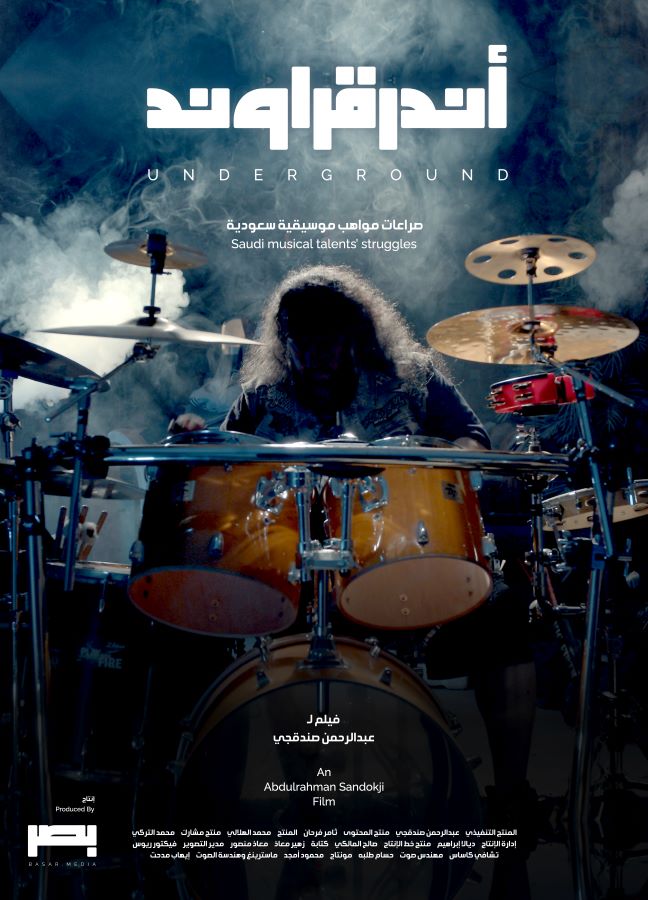DHAHRAN: The 10th Saudi Film Festival will begin May 2 at the King Abdulaziz Center for World Culture (Ithra) in Dhahran.
This year’s eight-day event — organized by the Cinema Society in partnership with Ithra and with support from the Ministry of Culture — will feature 76 film screenings and 53 titles vying for 36 awards. The red carpet will be rolled out on both opening and closing nights, with filmmakers, actors and film buffs in attendance. There will be workshops and book signings and, of course, the opportunity for filmmakers from the Kingdom and the wider region to come together.

The festival will open with “Underground,” a feature-length documentary by Saudi director Abdulrahman Sandokji about the Kingdom’s music industry. (Supplied)
The festival will open with “Underground,” a feature-length documentary by Saudi director Abdulrahman Sandokji about the Kingdom’s music industry.
Festival director Ahmed Al-Mulla said at a press conference: “This event is fast developing into a must-attend festival across the GCC film community. This year’s 10th edition is shaping up to be the biggest and best yet.”
“We have come a long way over the past decade and are pleased to see Saudi Film Festival’s importance and popularity across the region’s film community growing each passing year,” added SFF vice president, Mansour Al-Badran. “(It) has become a portal for cultural exchange and exploration, providing an avenue for cultural openness for the Kingdom and building bridges beyond borders for new programs and experiences.”

Syrian filmmaker Mohammad Malas will be honored at this year’s Saudi Film Festival. (AFP)
The festival’s colorful history — back to its debut in 2008 — will be on display at the Cinema Society’s “Saudi Encyclopedia of Cinema,” which includes 20 books covering all aspects of film.
This year’s edition has two main themes: Indian cinema and sci-fi films. The Spotlight on Indian Cinema program will explore India’s rich film industry beyond Bollywood and showcase Indian indie movies, which rarely get the chance to run in the Gulf region. Practical workshops and cultural seminars will be included for both the main themes, as well as programming designed especially for children.
The Plaza at Ithra will bring the future to the present by providing a Virtual Production Experience (NeoCyb) experience. Combining live-action film with digital environments or elements in real-time, virtual production uses advanced technologies such as real-time rendering engines and motion-capture to create immersive virtual environments that performers can interact with, enabling filmmakers to visualize and capture scenes with complex visual effects more efficiently and cost-effectively, by reducing the need for extensive post-production work.
And speaking of production, the festival also includes a production market where people can meet up to work towards a common goal: making more movies. Filmmakers, producers, funders — and those seeking funding — will be present. The market is designed, the organizers say “to enhance the film industry in Saudi Arabia by encouraging collaboration between artists, producers, and investors in the cinema industry.”
A total of 53 features, shorts and documentaries, nominated by the festival’s technical committee, will compete for 36 prizes at this year’s SFF. They will be displayed at the festival in three categories: the Film Competition, the Unexecuted Screenplay Competition, and the Production Market Projects Competition.
There will also be a new category of prizes up for grabs: The Golden Palm, which will be presented to the best Saudi documentary about the environment as well as a second-place award for the best animated short film on the topic.
On the sidelines of all the high-profile screenings, the festival also includes a myriad of activities for film professionals, including 10 training workshops, two of which will focus on production market participants and short- and long-scenario development. There will also be a symposium and a total of 13 masterclasses covering a wide range of topics. More details are available on Ithra’s website.
SFF will also continue to celebrate the achievements of film pioneers in the Kingdom and the Gulf region. This year, the festival will honor Saudi actor Abdulmohsen Al-Nemer, who hails from nearby Al-Ahsa.
Al-Nemer has starred in numerous films over his decades-long career, including “The Sun” (1990), “Shadows of Silence” (2006), “Thobe: The Wedding” (2016) and “Long Road” (2022).
He also starred in last year’s award-winning “Hajjan,” an Ithra Film Production that premiered at the 2023 Toronto International Film Festival and recently took home three awards at the Gulf Film Festival including Best Feature, Best Actor and Best Cinematography.
The festival will also honor Syrian director, Mohammad Malas, whose work has often been banned in his homeland but is recognized as one of his country’s leading auteurs. His documentary about Palestinian refugee camps in Lebanon, shot in the Eighties, “Al-Manam” was awarded first prize at the first International Documentary Festival in France in 1987.




























